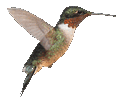

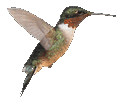
 The Hummingbird is the world’s smallest migrating bird. Named after the humming noise their wings make in flight, the hummingbird is the only bird species which can fly backwards, a useful skill as it feeds on the nectar of plants, and insects. 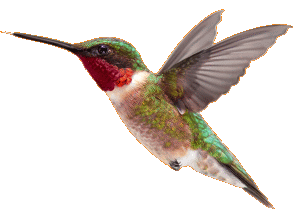 Living in the Americas, including the tropics in Central and South America and the Caribbean countries, the most common hummingbird seen in Canada and the United States is the vibrant ruby-throated hummingbird, pictured at the right and buzzing around this page in annoying fashion!
Living in the Americas, including the tropics in Central and South America and the Caribbean countries, the most common hummingbird seen in Canada and the United States is the vibrant ruby-throated hummingbird, pictured at the right and buzzing around this page in annoying fashion!
There are over 350 known hummingbird species, with new species being described every year. Hummingbirds are their own family, known as Trochilidae. Hummingbirds eat a diet of nutrient-rich flower nectar, sap and insects. Insects eaten include spiders, insect eggs and other small insect species which all provide essential protein and energy. Most hummingbirds weigh between 2.5 and 6.5 grams, although the bee hummingbird of Cuba, the smallest bird in the world, weighs just 1.7 g, about the weight of a standard paperclip. It's dwarfed by many insects; half of its total length of 5.5 cm is bill and tail. Its tiny nest measures barely 2.5 cm across, and its eggs are smaller than coffee beans. At the other end of the spectrum is the giant hummingbird, which is about 23 cm long, and weighs as much as 24 g. This is approximately the same length as a European starling. 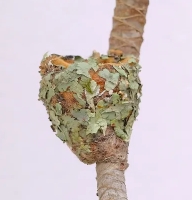 Hummingbird nests aren't always easy to find, but small as they are, they are wonderfully made, crafted from lichen, mosses and spider silk. They're often hidden in the fork of a branch, along a thin twig or buried deep inside a protective bush.
Hummingbird nests aren't always easy to find, but small as they are, they are wonderfully made, crafted from lichen, mosses and spider silk. They're often hidden in the fork of a branch, along a thin twig or buried deep inside a protective bush. Hummingbird species flap their wings at different speeds, with the giant hummingbird's wings beating as few as 12 beats per second. Most species flap their wings up to 80 beats per second, making them a blur to the human eye. Hummingbirds move their wings in a figure-eight pattern, giving them the unique ability to hover for long periods of time, and fly backwards. A hummingbird's heart rate can reach over 1200 beats per minute - more than 20 beats every single second! Their hearts are far too small to hear their heartbeats, but if it were possible, they'd be beating so fast that it would just be a high-pitched hum. Hummingbirds have incredibly fast metabolisms, so they're always hungry. They need to consume about half their own body weight every day. Hummingbirds' need to eat means that they would starve overnight if they slept in a normal way. Instead, they go into a deeper state of sleep that's more like a mini hibernation, called torpor, where their metabolism slows right down. 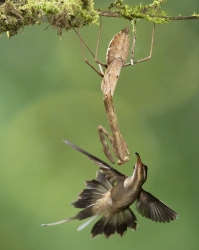
Hummingbirds, being so small, have a number of predators. Reptiles like snakes and lizards, as well as large frogs, will all eat them, and so will fish that jump out of the water to catch them. Other birds will also eat hummingbirds; small birds of prey like kestrels will kill them, as will shrikes, corvids and roadrunners. Large praying mantises (picture at right) will wait at birdfeeders to grab a small hummingbird, and hummingbirds can even get caught in the sticky webs of orb-weaver spiders. Hummingbirds aren't even safe at night, as bats and owls will both eat any they find roosting in the dark. 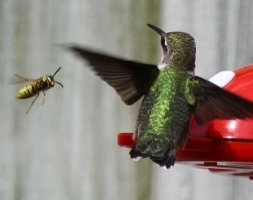 Hummingbirds, wasps and bees are all attracted to the same food sources, whether its flowers and their nectar, or hummingbird feeders full of sweet liquid.
Hummingbirds, wasps and bees are all attracted to the same food sources, whether its flowers and their nectar, or hummingbird feeders full of sweet liquid. Not only do the bees tend to hog the food sources, but hummingbirds will usually give way to bees and fly off, as they can't risk getting stung; one sting from a bee or wasp could kill a hummingbird. A typical wild hummingbird lifespan is anywhere from 3 to 5 years, but individual hummingbirds have been known to live for up to 12 years, and slightly longer in captivity. Many hummingbirds spend the winter in Central America before migrating northwards for the breeding season in spring. Individual birds will often leave or arrive on their breeding grounds on almost the exact same day every year. Rufous hummingbirds have the longest migration of all, traveling more than 6000 km between Mexico and Alaska. Even more impressive is the ruby-throated hummingbird, which flies 800 km nonstop across the Gulf of Mexico. It takes them 20+ hours to make the crossing, remarkable for a bird that must normally eat 5 to 8 times every hour to avoid starvation. Hummingbirds use their tongues as tiny elastic pumps, which work in a similar way to how we drink from straws. They use elastic energy stored at the base of the tongue to bring up nectar, rather than creating a partial vacuum in a straw like we do. This all happens at high speed - a hummingbird's tongue will go in and out of a flower up to twenty times per second! |